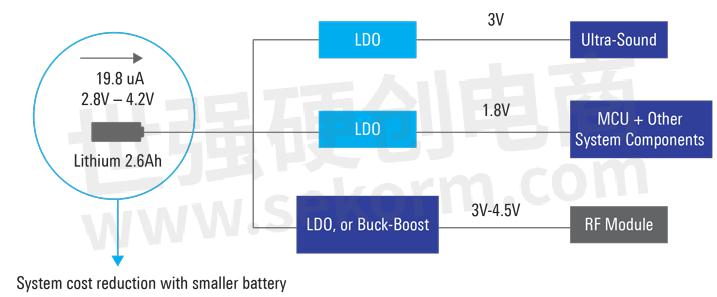Use Renesas Buck-boost Converter ISL9122 to Conserve Battery Power in IoT Devices

Recent trends in battery operated devices increase demand on powering always-connected IoT and strongly favor efficient DC-DC power conversion products. Target markets for battery operated products include virtually all battery operated devices where battery life has to be long compared to average power consumption. This is especially true for devices that require a lifetime of days to years.
In addition, increased adoption of wireless connectivity drives the need for voltages higher than that of the battery and at the same time, requires a more efficient use of battery charge. DC-DC converter devices that can dynamically change their output voltage based on the needs of the application can greatly enhance the efficiency and extend the battery lifetime. Our new ISL9122 buck-boost converter satisfies all the power requirements mentioned above.
Key features
The ISL9122 belongs to a family of ultra-low Iq DC-DC regulators with advantages that can be grouped into three different categories:
1. Battery voltage range: With an input voltage range of 1.8V to 5.3V, this family of regulators are suitable for applications with multiple types of batteries, such as Alkaline, LiOn, Li-Polymer
2. Power consumption: This family of parts have three distinct advantages with respect to battery life – low Iq , 1.3 µA, and shutdown current < 9nA – allowing batteries to last for a very significant amount of time
3. Flexibility: The I2C interface provides maximum flexibility to change output voltage in 25 mV increments which allows system designers to change Vout dynamically depending on the power needs of the system
Application examples
Water and Gas Meters: One use case for a DC-DC converter such as ISL9122 is in water and gas meters which typically require > 10 years of battery life. Below is an example comparing power conversion done a typical design using an LDO with a new design using a DC-DC converter such as ISL9122.


Figure 1. Battery Life Optimization for Energy Management Systems
As seen in top block diagram, an implementation using an LDO for power conversion on average draws 19.8 µA from the battery. Since LDOs are very inefficient when there is a large conversion ratio between the input and the output, most of the charge in the battery is converted into heat and wasted. When ISL9122 is used instead of an LDO, the current drawn from the battery to run the same application is reduced on average to 12.9 µA. This example shows that when using ISL9122, the lifetime of the battery can be increased by 50%. Or equivalently, the cost of the battery can be decreased by 50%.
RF Optimization for IoT: This example shows how using DVS (Dynamic Voltage Scaling), Vout can be increased whenever there is a need to transmit data wirelessly to the network. During times when there is no transmission or the wireless interface is in sleep more, the regulator output can be reduced enough to sustain the MCU. Since power consumption increases with the square of the voltage, reducing Vout when not needed saves a significant amount of power.

Figure 2. RF Optimization for IoT Systems
The new class of ultra-low Iq DC-DC regulators from Renesas are the ideal power solution for any device powered by a small battery. With ultra-low Iq, high efficiency at both light and heavy loads, as well as fast transient response these devices maximize battery life without any compromise in performance. In particular, the small, highly flexible ISL9122 buck-boost regulator increases battery life for connected smart devices.
- +1 Like
- Add to Favorites
Recommend
- Renesas DSP Solution on Renesas Lab on the Cloud, Input Analog Signals Directly From A Signal Generator To The Rx231 Microcontroller Evaluation Board
- Renesas‘ Semiconductor Manufacturing Factory (Naka Factory) Fire: Production Capacity Has Recovered to 88%
- Renesas Announces 10 New Winning Combinations Integrating Celeno and Renesas Products
- Renesas & Altran to Deploy First Social Distancing Wristwatch Using Ultra-Wideband Chipset with Low Rate Pulse
- Renesas and FAW Establish Joint Laboratory to Accelerate Development of Next-Generation Smart Vehicles
- Renesas Semiconductor Manufacturing Factory (Naka Factory)‘ Production Level Has Returned to 100%
- Renesas and Sequans Expand Their 5G Collaboration including Broadband IoT Module for 5G NR FR1/FR2
- Most Common Wholesale DC-DC Converters
This document is provided by Sekorm Platform for VIP exclusive service. The copyright is owned by Sekorm. Without authorization, any medias, websites or individual are not allowed to reprint. When authorizing the reprint, the link of www.sekorm.com must be indicated.






























































































































































































































































































































































































































































































































































































































































































































































































































